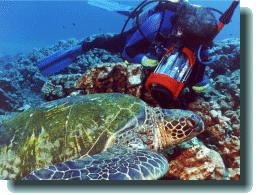
73K JPEG
1Turtle Trax, 24 Reid Dr, Unit 3, Mississauga, Ontario, Canada L5M 3A6
2National Marine Fisheries Service, Southwest Fisheries Science Center, Honolulu Laboratory, Honolulu, 2570 Dole Street, Honolulu, Hawaii 96822, USA

|
| Videotaping Raphael, 1992 Turtle 26a |
73K JPEG |
Site fidelity to a particular stretch of coastal waters is a recognized characteristic of the Hawaiian green turtle, or honu. (Balazs, 1980; Bennett et. al., In press; Keuper-Bennett and Bennett, In press). The turtles living at Honokowai, West Maui, Hawaii are also dedicated "reef potatoes."
Through benign observations using photographs and videotape, conducted during July and August each year from 1989 to 1999, we have shown that turtles from all post-pelagic size classes have called Honokowai home for many years. (Keuper-Bennett and Bennett, In press)
Further, we have discovered that the honu are faithful not just to a general area such as the Honokowai reef system, but also to specific places on the reef. We have documented numerous areas that individual turtles regard as "private" resting sites. These are specific ledges, shelves, and depressions that become "home" to one turtle. The same animal can occupy its private space for years and will defend it stubbornly from intrusion by other honu.
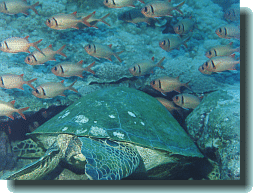
| 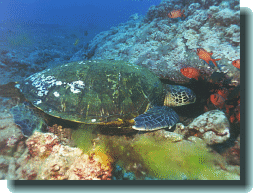
|
| Zaphod with her head under a coral ledge in 1995 | Zaphod, about to stick her head under the same ledge in 1998 |
60K JPEG | 57K JPEG |
The consequences of such site-specific residency are clearly visible on the reef. Turtles engage in three types of activities causing three forms of destruction. Finger corals are broken and trampled, plate and lobe corals are ground smooth, and large coral heads are split asunder.
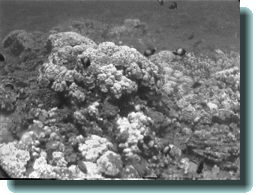
| 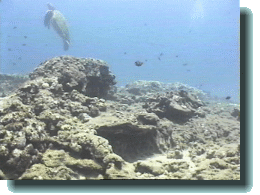
|
| The Key Mound coral head, a popular turtle resting place, in 1989 | The same coral head in 2000 (Really!) |
60K JPEG | 57K JPEG |
The area we call the Turtle House was a mound of thriving corals in 1989. A decade later, these corals are unrecognizable, having been pummeled into rubble or ground down to their rock base. A colony of honu can indeed change the landscape--and do so dramatically! Whether it's a case of many turtles huddled around a shared piece of habitat (such as a scratch post) or that of an individual turtle calling a ledge home, the results are the same. As these hard-shelled creatures come and go for daily foraging and resting, the environment bears testimony to their long-term presence.
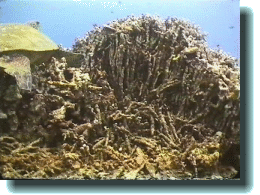
|
| Classic example of a "Turtle Trample" |
66K JPEG |
The effect of 100 kg turtles taking off and landing atop corals leaves little to the imagination, but honu can do damage even when resting. Fragile finger corals (Porites compressa) are major victims. Their remains litter the "floors" of most Honokowai resting places. We call these sites "Turtle Tramples" because that's exactly what the turtles do, even during the course of such an innocent activity as resting. They trample and grind the corals into rubble simply by physical contact.
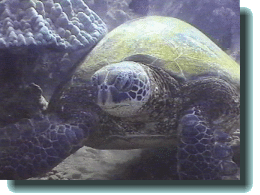
|
| Noe, 1997 Turtle 16, using a coral ledge as a scratching post |
44K JPEG |
Generally speaking, an "itchy" plastron is the easiest itch to satisfy. A honu simply needs to drag itself over a section of coral using its front flippers to move itself back and forth. If an "armpit" or abdominal region is itchy, a turtle can find relief on any handy piece of coral; however, a coral head that offers top-quality easy access for armpit/abdominal scratching becomes a shared resource. Over time it can be worn to a point, thus making it an even more effective itch "satisfier."
While scratching plastron and soft body parts is easily accomplished, there is a logistical problem with an itchy carapace, since a turtle can't (or won't) roll over. To satisfy this kind of itch requires some overhanging structure. For small turtles, any ledge or coral "lip" works well. Large turtles, however, require suitably sized overhangs of either rock or durable coral--and therein lies the problem.
Honokowai offers few coral structures of the necessary size, and the few that exist attract intensive and prolonged bouts of scratching. During our decade of observations we've determined that no corals are durable enough to withstand the relentless carapace rubbing and scraping inflicted on them by large and powerful itchy honu. Three of Honokowai's five most prominent and "popular" scratch posts have split and collapsed--one in 1991 and the other two in 1998-99.
We have occasionally documented green turtles foraging for sponges growing among corals. To get at these morsels, a turtle will use its flippers to pry away coral projections. In 1999, we were fortunate to witness the foraging habits of two Hawaiian hawksbills ('ea). These turtles flail their flippers with even more enthusiasm than their larger honu brethren. The two species exhibit interesting differences in sponge foraging behaviour. Green turtles work the perimeters of Honokowai reef systems, while the hawksbills will turn their attention anywhere they sense a sponge might be located. As a result, the honu and 'ea leave somewhat different "calling cards" of damage around their Honokowai reef homes.
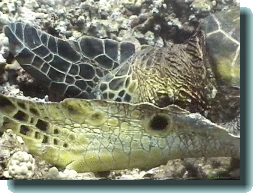
| 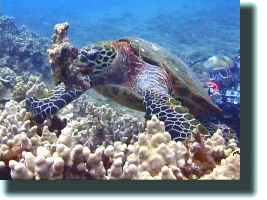
|
| A honu flailing the coral as she forages for orange sponge | The 'ea Ake foraging for sponges in 1999 |
66K JPEG | 74K JPEG |
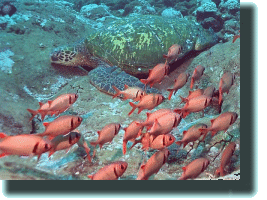
|
| The Depression, the center of a huge coral head, where honu like to stretch out |
75K JPEG |
This type of damage is subtle and is done mostly to large corals, such as lobe corals (Porites lobata). Years of plastron-rubbing have ground portions of these coral heads smooth. In 1989, when we first discovered the Turtle House, the portion of it that we called The Depression showed enough erosion to suggest that turtles had already used it as a resting area for years. The number of turtles has increased, however, and the corals at The Depression haven't stood a chance. They've been ground down, smoothed, and eroded more between 1996-99 than in all previous years under observation.
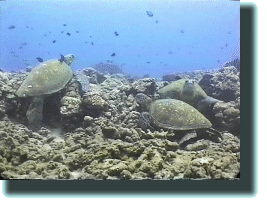
|
| The Turtle House after a decade of honu activities |
57K JPEG |
This is the most extensive form of reef damage at Honokowai. Foraging or arriving and departing can be the cause, but it primarily results from movements while resting on the corals. Because the Turtle House was "established" first as a honu cleaning station and rest site, the once flourishing corals of 1989 (mostly P. compressa) are barely recognizable today. A decade of honu presence in this area gives it a look similar to the break-and-scatter damage wreaked by a hurricane.
This type of damage is the most pronounced. Massive coral structures sheer and collapse as a result of the honu's need to satisfy carapace itches. The Key Mound--a carapace scratch post at the Turtle House--was sheared in half between 1990 and 1991. East House, a prominent lobe coral structure at Reef 2, collapsed in 1999. Both structures almost certainly fell victim to large adults doing "push ups" from underneath in order to drag and scrape their shells along the coral overhang.
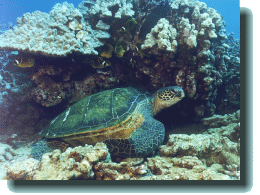
| 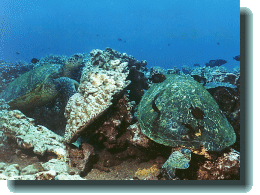
|
| The East House coral ledge, popular for scratching and resting, in 1997 | The remains of the East House coral ledge in 1999 |
74K JPEG | 57K JPEG |
The condition of the corals at the Turtle House in 1989 suggests that honu were not established in significant numbers at that time. Retrospective video analysis demonstrates that most Honokowai coral destruction is recent, occurring only in the last decade and largely attributable to honu activity.
The obliteration of corals has affected other marine inhabitants that lived at the Turtle House before honu colonization. For example, review of video of the Rest Site, a severely trampled area just east of the Turtle House, shows fewer fish in 1999 than in 1989 footage.
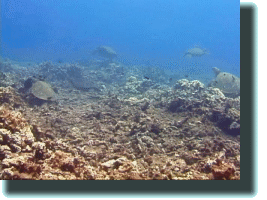
|
| North House in 1999, where it is common to see a dozen honu resting together |
54K JPEG |
We are left to wonder what happens when portions of reefs are turned into rubble. Will the honu move to alternate locations? We already seem to have evidence of that happening with newly discovered congregation areas such as North House, approximately 250 metres northeast of the Turtle House.
What consequences, if any, might the destruction of corals and other honu-induced effects on habitat have on the course/expression of fibropapilloma disease within this population?
Last, can the corals ever recover in the daily presence of so many of Hawaii's splendid and charismatic turtles?
Balazs, G. H. 1980. Synopsis of biological data on the green turtle in the Hawaiian Islands. U.S. Dep. Commer., NOAA Tech. Memo. NMFS-SWFSC-7 and University of Hawaii Sea Grant Cooperative Report CR-81-02, 141 p.
Bennett, P. A., U. Keuper-Bennett, and G. H. Balazs. In press. Remigration and residency of Hawaiian green turtles in coastal waters of Honokowai, West Maui, Hawaii.
Keuper-Bennett, U. and P. A. Bennett. In press. Home Sweet Home: Aspects of green turtle and hawksbill presence in their feeding, resting and cleaning areas off Honokowai, West Maui, Hawaii (1989-1999).
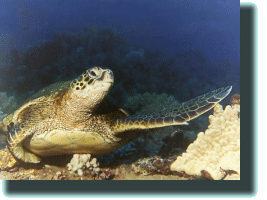
|
| Charisma |
38K JPEG |
 Who's Who Underwater at Honokowai
Who's Who Underwater at Honokowai